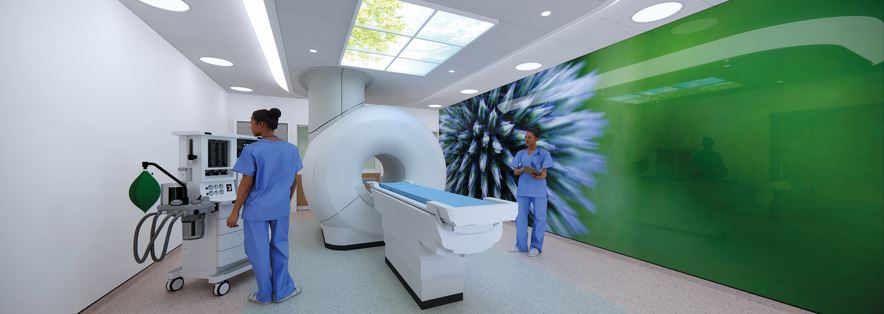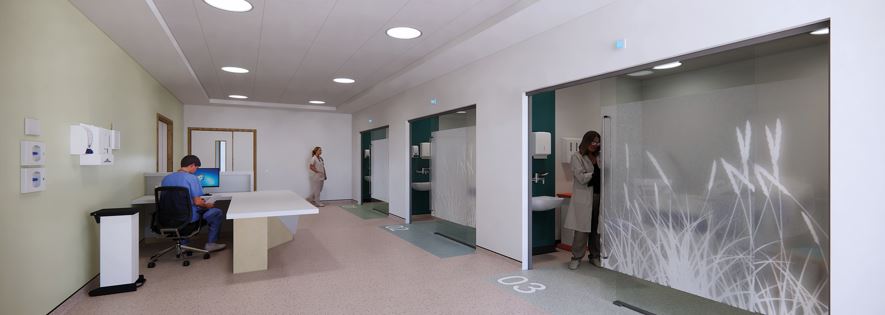
In recent years, the healthcare industry has been undergoing a transformation, with a focus on improving accessibility and efficiency of diagnostic services. James Withey, managing director at Algeco Offsite, looks at why latest platform design solutions are helping roll out the benefits of Community Diagnostic Centres faster than other construction techniques.
Community Diagnostic Centres (CDCs) provide essential tests and scans to patients, allowing for faster and more accurate diagnoses. They have emerged as a crucial component of a modern healthcare system, aimed at providing patients with access to planned diagnostic care closer to home. These centres were recommended following the Review of NHS diagnostics capacity by Professor Sir Mike Richards, with the goal of improving patient experience and outcomes. CDCs play a vital role in improving population health outcomes by diagnosing health conditions earlier, increasing capacity in the diagnostic service, and reducing health inequalities by ensuring equal access to care for all individuals. Additionally, CDCs support more joined-up care across primary, community and secondary healthcare settings. Thirteen new CDCs have already delivered 742,000 additional scans, tests and checks a year. Demand for diagnostic tests continue to increase as more than 85 per cent of patients seeking NHS care now require this service. Finding out what is wrong with a patient is vital to treating them as early as possible and as of April 2023, around 1.6 million people in England were waiting for a diagnostic test. This waiting list has been growing steadily since 2008. Over the past 12 months, 24.6 million checks and scans have been carried out and the latest CDC’s have now contributed to more than 4 million towards this target. The national target is that 99 per cent of patients should wait less than six weeks for a diagnostic test. The UK currently has less diagnostic equipment than comparable countries; it has 8.8 CT scanners per million population, 25th out of 28 OECD countries, and the number of MRI units and PET scanners are also below average. NHS England estimates that demand for CT scans will rise by at least 100 per cent in the next five years.
THE BENEFITS OF MODULAR CONSTRUCTION
One of the primary advantages of modular construction when it comes to the roll out of CDCs is its ability to significantly reduce construction time. Traditional construction methods can be time-consuming and subject to delays on site, including shortage of skills. Ultimately, this leads to longer wait times for patients in need of diagnostic services. In contrast, platform-design modular construction systems allow for simultaneous off-site manufacture and on-site preparation of foundations and service connections, resulting in faster completion times. This means that CDCs can be up and running in a shorter timeframe, providing much-needed diagnostic services to patients promptly.The main benefit of a platform-design approach for manufacturing the building modules is that it makes full use of the latest in digital and manufacturing technologies. It delivers higher performing and better-quality buildings that can be mass produced and delivered within shorter timescales. On a practical level, the platform-design is a lightweight steel frame building module made up of standardised interoperable elements. In accordance with the Construction Innovation Hubs Platform rule book it provides unlimited configuration to enable the efficient construction of any building regardless of type or use. This platform-design approach can reduce construction costs by 33%, enable completion of projects 50% faster, and reduce emissions by 50%, all with zero compromise on build quality or safety. The approach also meets the Government’s Construction 2025 targets. In terms of sustainability, analysis shows that the platform-design approach comprises 581.3 kg CO2e per m2, which is well below the Construction 2025 target of 1,300 kg CO2e per m2. In addition, because the CDC modules we supply can be reused, either by relocating to other sites or by refurbishing individual components and cassettes, it adds a 234 kgCO2e per m2 clawback.
CASE STUDY: MODULAR CDCS
An example of modular construction revolutionising delivery of healthcare building – in this case CDCs - is our partnership with Hygieia. This collaboration has led to the development of a new range of standardised CDCs using our platform-design modular construction system. Hygieia, a consortium of leading companies specialising in healthcare modular buildings, now offer three standard sizes for CDCs: small, medium, and large. These standardised formats provide a cost-effective solution for NHS Trusts and the private sector, allowing for rapid construction and delivery. The CDC’s are offered with a full design, delivery, construction, and finishing service, a comprehensive approach that allows customers to start using their CDCs from day one, eliminating the need for separate contractors. They also incorporate all necessary servicing, including specialised electronics needed for sensitive imaging equipment, further streamlining the implementation process. Our ability to offer a full turnkey solution was achieved by partnering with some of the leading brands in the sector, such as Tata Steel, P+HS Architects and CAD21, amongst others. The CDCs are fully compliant with HTM / HBN requirements.

THE WAY FORWARD
The introduction of modular CDCs has had a significant impact on the healthcare landscape, addressing the growing demand for diagnostic tests and scans. These centres have played a crucial role in reducing waiting times for patients, diverting them away from hospitals and providing faster access to essential diagnostic services. Modular CDCs have also contributed to reducing health inequalities by ensuring equal access to care for all individuals. By bringing diagnostic services closer to communities, these centres eliminate the need for patients to travel long distances for essential tests, especially in areas with higher health risks.
To find out more about Algeco CDCs and other healthcare solutions, visit:
